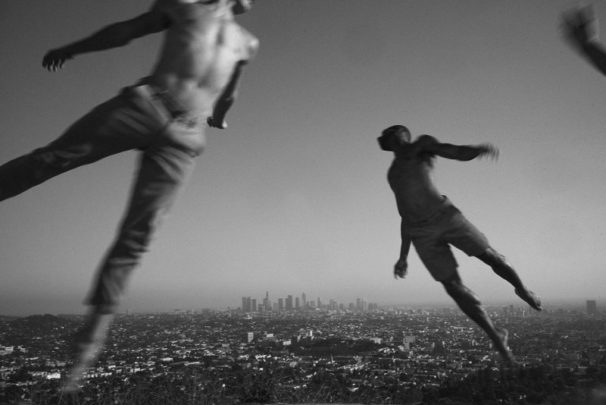
A harrowing drive across dark, slick, and unmarked Washington Boulevard in pelting rain went unrewarded by enduring Benjamin Millepied’s “I Fall, I Flow, I Melt,” a 75-minute, intermission-less dance performance by L.A. Dance Project performed in the round at the company’s newish headquarters named for its address, ‘2245.’
The choreography for this random and soulless performance piece for twelve dancers, in groups, solos, duets, quartets set primarily to music by Bach, is credited in part to the dancers themselves. I prefer to treat it like the current government shutdown—which belongs to one man—by placing the evening wholly at the doorstep of Mr. Millepied. No cop outs, sir.
L.A. Dance Project’s repertory mixes in works by other dance makers—Justin Peck, Kyle Abraham, Martha Graham, Ohad Naharin, and more. But when it comes to its founder’s own creativity, the ‘project’ has plowed a path of dance disappointment since Millepied famously planted his flag in Los Angeles seven years ago. His hard-working troupe has a few beauties, particularly among the women. I liked the curvaceous Rachelle Rafailedes and the high-kicking Madison Hicks. But the troupe, for me, does not cohere. Their ballet technique is just so-so. They thud heavily to the floor as though their study of modern dance is not deep. They’re not funky, and when performing, they don’t appear to enjoy it much. One would pity them, watching them labor, except that they are among the scant few contemporary dancers with real salaries. But they work hard for the money by being incorporated into Mr. Millepied’s nonsensical productions like “I fall …”
Millepied is a proven impresario of major events. (He should be. For a short time, he ran the Paris Opera Ballet.) That he assembled the disparate parts of “I fall…” into a single outing is no small feat. His obvious directorial skill as well as his arts entrepreneurship have resulted in the company’s smart new headquarters in industrial L.A. … miles from where anyone lives … or can find a bite to eat. That may change. That’s the way it is now.
He has dancers, he has space, he has patronage. But despite all these blessings, Mr. Millepied does not improve as a choreographer. The needle is stuck in a certain mode. Along those lines, “I fall…” showcased the familiar. For this viewer, Millepied lacks the right stuff, the basic skills needed for the job. He lacks chops.
“I fall…,” the very title of which signals weakness, opens weakly. Set to a ponderous score — liturgical music oddly out of sync with our times, the program also bundles in an eensy-thin minimalist “counter” score by David Lang, an L.A. Dance Project collaborator. The aural pummeling of the recorded track contrasts to Etienne Gara’s hearty delivery of live music on unaccompanied violin.
In a prologue that a good choreographer would let fall to the cutting-room floor — because it just doesn’t work — the dancers file into ‘2245”s high-ceiling’ed space, each carrying his or her own wooden chair — like kindergarten kids. After forming a circle, they devolve into Millepied’s fussy movement non-sequiturs that stem from nothing.
Performing this work, the dancers do not come off as adults. They seem childish. But that is pure Millepied. He likes to dress dancers in little shorts and sports tops and white “Ked” sneakers (although in “I fall …” they wear an array of ballet slippers, pointe shoes, bare feet, socks and little sockettes). There is an abundance of trotting around the room. Run over there to do something. Run somewhere else to do something else. It’s like watching recess.
To the sound of St. Matthew Passion and the C-minor Passacaglia for organ, music that shook the rafters of European churches and made congregants tremble in awe, Millepied set about reducing the music. My mind ran to the Great Ones who took on Bach, famously Doris Humphrey, but also Limon, Taylor, Balanchine and Robbins. They are seminal works by choreographic masters each with a distinguished dance language that you can identify in eight counts.
By contrast, Millepied’s language, even in its endless piling on, is a hybrid. It emanates not from his classical ballet pedagogy. Nor does it belong to any identifiable contemporary/modern dance vernacular. It’s a little this, a little that, and, to be perfectly honest, it can be so ugly. One locus of badness is in the arms. They flail, as add-ons, disconnected to the spine. They wind-mill, or he randomly raises an arm, or both, to the ceiling with portentousness. The inorganic nature of his choices and how he strings together movement (not well) is disjunctive for the viewer. It is in this core vocabulary and knitting together (the ‘nuts and bolts’) that Mr. Millepied falls short.
“I fall…” had select strong moments. One was a bouncing balletic trio for men dressed in designer Alessandro Sartori’s black-and-white striped tunics. This ebullient explosion of male bravura let the men rip with macho power. The work’s most memorable swathe arrived, as does everything, out of nowhere. In glowing orange light, Anthony Lee Bryant, a beautiful dancer stretched his long limbs. His glowing humanity shone in contrast to the robotic mien worn by the rest of the dancers. The bear hugs between dancers at the end of this odd, cold, dissociative evening of dance felt fake. But the performance got a standing ovation. That is de riguer — no matter what the audience truly feels.
arts·meme founder/dance critic Debra Levine authored this review.
I Fall, I Float, I Melt | L.A. Dance Project | thru Jan 20
